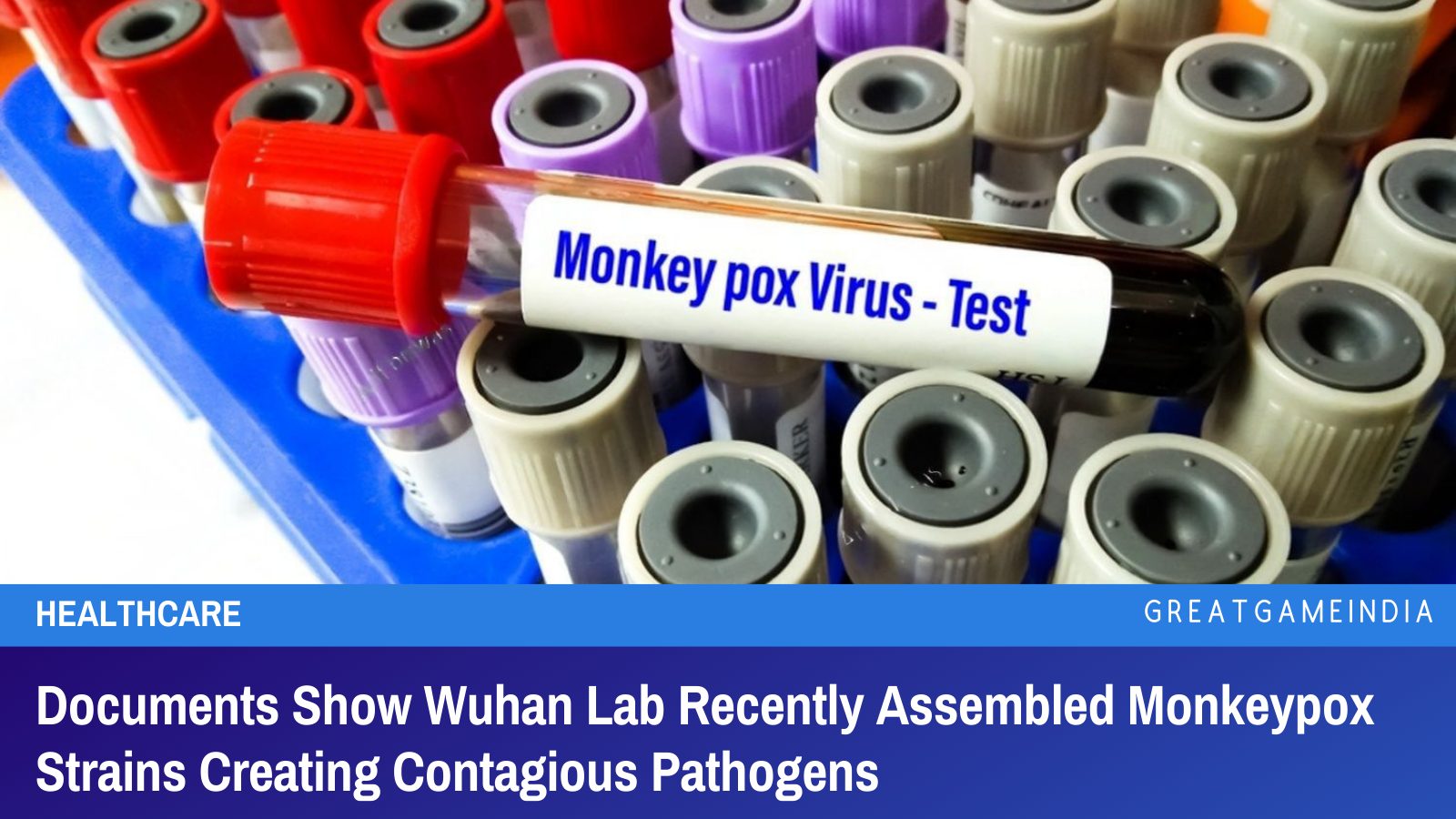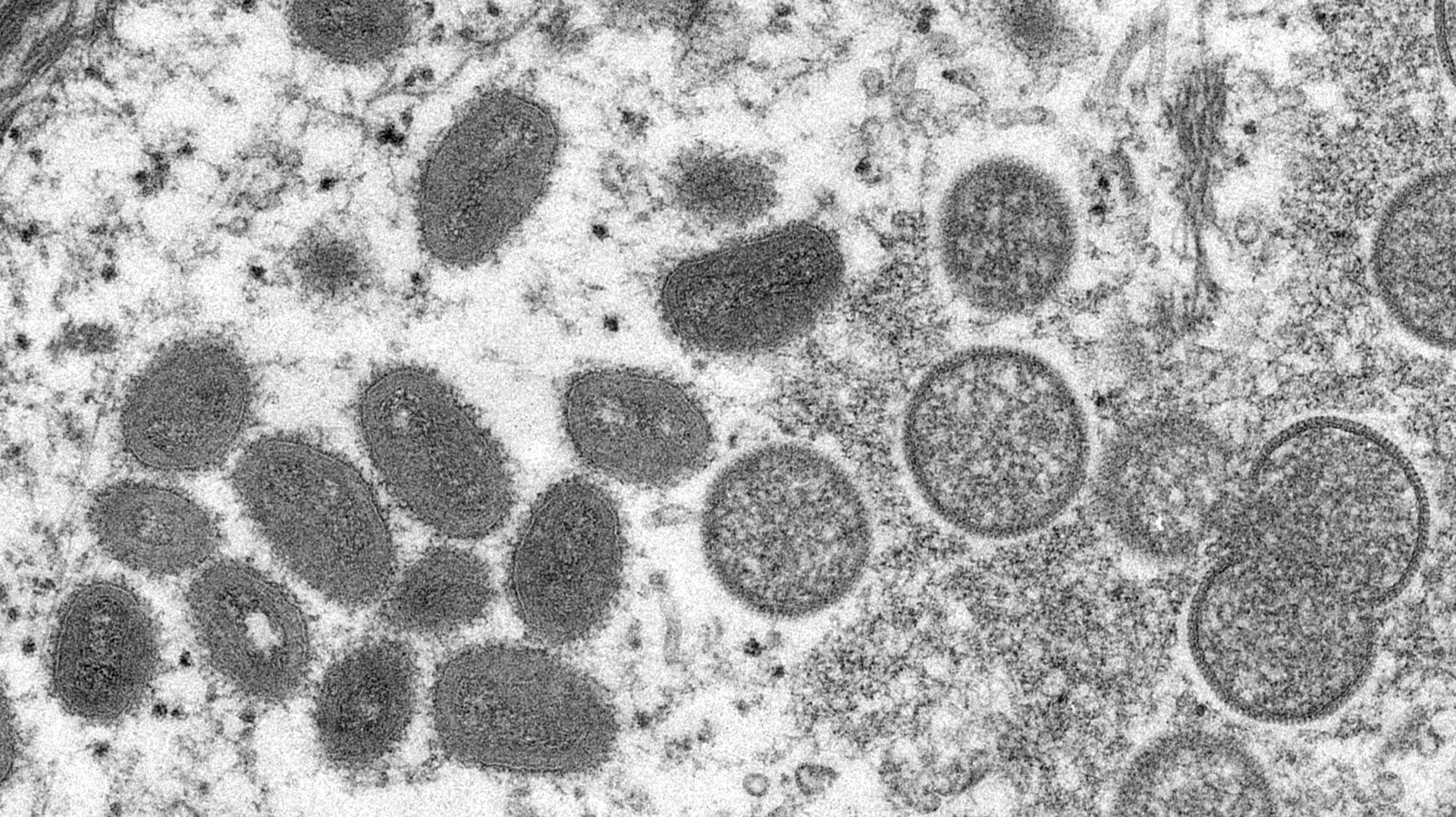Announcement
Collapse
No announcement yet.
Discussion - Thoughts on a global outbreak of monkeypox
Collapse
X
-
Tonix stock crashed after monkeypox outbreak. (Who would want a pox-vectored Covid vaccine now?) The horsepox virus was brought back to life in Canada for only $100,000. (Money was officially from Tonix - but who financed them?) I think the Canadian lab is the same one the US NIH is working with to do the universal coronavirus vaccine research now.
The earliest monkeypox symptom onsets reported were in Canada and England. The early case in Canada has no international travel history reported.
 This post contains sponsored advertising content. This content is for informational purposes only and is not intended to be investing advice.
This post contains sponsored advertising content. This content is for informational purposes only and is not intended to be investing advice.
At Tonix, we have developed horsepox as the viral vector, which is the “sheep” in this analogy, and we have engineered it to express the spike protein from SARS-CoV-2 as the antigen, which is the “wolf’s clothing”. The foundational work on this vector can be traced back to the 18th Century and the creation of the very first vaccine that led to the eradication of smallpox.
But we are working on a very modern version called horsepox. It wasn’t possible to make our vaccine until synthetic biology emerged as a new field. A few years ago, making our vaccine was at the forefront of synthetic biology. We think that horsepox is still the largest virus ever synthesized. We believe horsepox is the most advanced form of a series of pox viral vectors, and that horsepox has capabilities beyond those of the canarypox vector that was used in the HIV vaccine Thai trial.
-
Documents Show Wuhan Lab Recently Assembled Monkeypox Strains Creating Contagious Pathogens
May 23, 2022
The Wuhan Institute of Virology admitted that its premises lacked basic laboratory safety measures while undertaking comparable research on strains of killer bat coronaviruses that could potentially infect individuals. Now, explosive documents show that the Wuhan lab recently assembled monkeypox strains creating contagious pathogens.
The Wuhan Institute of Virology built a monkeypox virus genome, enabling the virus to be detected by PCR tests, employing a technology that scientists have warned could result in the creation of a “contagious pathogen.”
The paper (read below) was first published in February 2022, just months before the most recent international outbreak of monkeypox cases, which has now spread to the United States.
The report, written by nine Wuhan Institute of Virology experts and published in the lab’s quarterly scientific journal Virologica Sinica, also follows the widespread usage of Polymerase Chain Reaction (PCR) tests to detect COVID-19-positive patients.
In the study “Efficient Assembly of a Large Fragment of Monkeypox Virus Genome as a qPCR Template Using Dual-Selection Based Transformation-Associated Recombination,” scientists seemed to recognize a part of the monkeypox virus genome, allowing PCR testing to detect the virus. ...
 Another cause of concern has emerged from Wuhan Institute of Virology after it admitted that its premises lacked basic laboratory safety measures while undertaking comparable research on strains of bat coronaviruses. This time, documents show that the Wuhan lab recently assembled monkeypox strains creating contagious pathogens.
Another cause of concern has emerged from Wuhan Institute of Virology after it admitted that its premises lacked basic laboratory safety measures while undertaking comparable research on strains of bat coronaviruses. This time, documents show that the Wuhan lab recently assembled monkeypox strains creating contagious pathogens.
Leave a comment:
-
(Study referred to in above video, post #61, Pathfinder, NIH, Wuhan were working on monkeypox)
Efficient assembly of a large fragment of monkeypox virus genome as a qPCR template using dual-selection based transformation-associated recombination - KeAi
 Virologica Sinica
Virologica Sinica
Available online 28 February 2022
LeiYangabLingqianTianabLeshanLiabQiuhongLiuabXiangGuoabYuanZhouaRongjuanPeiaXinwenChenaYunWanga
Highlights
•The first TAR assembly system using dual-selection markers.
•Highly efficient TAR assembly system with a zero rate of vector recircularization.
•Assembly of an MPXV genomic fragment containing multiple qPCR detection targets.
Abstract
Transformation-associated recombination (TAR) has been widely used to assemble large DNA constructs. One of the significant obstacles hindering assembly efficiency is the presence of error-prone DNA repair pathways in yeast, which results in vector backbone recircularization or illegitimate recombination products. To increase TAR assembly efficiency, we prepared a dual-selective TAR vector, pGFCS, by adding a PADH1-URA3 cassette to a previously described yeast-bacteria shuttle vector, pGF, harboring a PHIS3–HIS3 cassette as a positive selection marker. This new cassette works as a negative selection marker to ensure that yeast harboring a recircularized vector cannot propagate in the presence of 5-fluoroorotic acid. To prevent pGFCS bearing ura3 from recombining with endogenous ura3-52 in the yeast genome, a highly transformable Saccharomyces cerevisiaestrain, VL6-48B, was prepared by chromosomal substitution of ura3-52with a transgene conferring resistance to blasticidin. A 55-kb genomic fragment of monkeypox virus encompassing primary detection targets for quantitative PCR was assembled by TAR using pGFCS in VL6-48B. The pGFCS-mediated TAR assembly showed a zero rate of vector recircularization and an average correct assembly yield of 79% indicating that the dual-selection strategy provides an efficient approach to optimizing TAR assembly.
https://www.sciencedirect.com/scienc...5820X22000414#!
Leave a comment:
-
NIH, Wuhan were working on monkeypox
May 31, 2022
Dr. John Campbell
2.34M subscribers
...
- Likes 1
Leave a comment:
-
Translation Google
Monkeypox present in Europe since mid-April, WHO says
3 hours ago
By Belga
Monkeypox has been present on the European continent since mid-April, according to Belgian doctor and WHO Regional Director for Europe, Hans Kluge. The lifting of health restrictions linked to the Covid-19 pandemic has had an impact on the advance of this virus, the expert told Belga.
According to Kluge, it is not certain that the spread of the monkeypox virus can be fully contained. “ Although a vaccine (MVA-BN) and a specific treatment (tecovirimat) for smallpox were approved, respectively in 2019 and 2022, they are not yet widely available ,” he explains. Therefore, human-to-human transmission should be stopped as much as possible.
This can be done by educating the population on how to reduce their risk of exposure, for example by reducing the number of their sexual partners. It is important that young people, regardless of gender and sexual orientation, know what to do if they think they have been exposed to the virus or are showing symptoms, adds the scientist.
He also calls not to stigmatize the homosexual community among which the first cases of monkeypox were declared. “ The virus is not intrinsically linked to a specific group of people ,” insists Hans Kluge.
Leave a comment:
-
Hattip Shiloh:
https://flutrackers.com/forum/forum/...te-29-may-2022
...
WHO risk assessment
Currently, the overall public health risk at global level is assessed as moderate ...the sudden appearance and wide geographic scope of many sporadic cases indicates that widespread human-to-human transmission is already underway, and the virus may have been circulating unrecognized for several weeks or longer.
The public health risk could become high if this virus exploits the opportunity to establish itself as a human pathogen and spreads to groups at higher risk of severe disease such as young children and immunosuppressed persons...
There is a potential risk to health workers if they are not wearing appropriate personal protective equipment (PPE) to prevent transmission.
...
Furthermore, there is the high likelihood of identification of further cases with unidentified chains of transmission, including potentially in other population groups.
...
WHO advice
...
During this current outbreak, many individuals are presenting with localized rash – oral, peri-genital and/or peri-anal distribution associated with painful regional lymphadenopathy – sometimes with secondary infection. These individuals may present to various community and health care settings including but not limited to primary care, fever clinics, sexual health services, travel health clinics, infectious disease units, emergency departments, dermatology clinics, obstetrics and gynaecology, and dental services. Increasing awareness among potentially affected communities, as well as health care providers and laboratory workers, is essential for identifying and preventing further secondary cases and effective management of the current outbreak.
...
Leave a comment:
-
Translation Google
Monkeypox: "we don't know much about the transmissibility of the virus"
Without dramatizing the situation, the Swiss epidemiologist Antoine Flahault calls for caution with regard to monkey pox. A virus about which we do not know much despite its discovery in the 1950s.
By Caroline Robin
Health journalist
Published on 05/30/2022 at 3:52 p.m.
1 case, then 7, then 16… The progression of monkeypox in France has an air of deja vu. But unlike Covid-19, no deaths are to be deplored among nearly 400 cases detected worldwide. If the disease seems mild and lasts only three weeks, it has several unknowns according to Swiss epidemiologist Antoine Flahault. The director of the Global Institute in Geneva calls on health authorities to remain proactive, given the “insufficient” level of knowledge of the virus to date. Interview.
Capital: Reading you on Twitter, it seems like we don't know anything about monkeypox. However, unlike Covid-19 which appeared at the end of 2019, this disease was discovered in the 1950s…
Antoine Flahault: It's true, we've known about monkey pox since 1958. This virus was discovered in a pet store. It was then necessary to wait until the 1970s for the first case to be identified in a child in the Democratic Republic of Congo (DRC). The virus then spread to West Africa. However, this is not enough to have a thorough knowledge of the virus.
Capital: Why?
Antoine Flahault: Because the countries of sub-Saharan Africa do not benefit from the same investment in research as the rich countries. Even in Nigeria, where the virus has been circulating regularly since 2017, we do not have the expertise equivalent to that of the countries of the North. And since monkeypox has never hit the headlines in Europe or North America, developed countries have not invested in learning more about this disease.
Capital: You mean that we don't really know the characteristics of monkeypox in terms of transmissibility and/or severity?
Antoine Flahault: We could draw an analogy with the chikungunya virus. When it reappeared in 2006 on Reunion Island, we quickly realized that we did not know much about this disease, its contagiousness... Conversely, the flu and gastro- enteritis, responsible for epidemics each year in Europe, are well known. Aside from that, Ebola is a little better known than monkeypox because it once worried Western countries. In fact, as long as the rich countries do not feel threatened, the research investment on the virus is neglected.
Capital: In France, however, the health authorities seem reassuring in the messages they send to the general public...
Antoine Flahault: They are partly right. Of all the cases identified, no deaths are to be deplored. From this point of view, the disease seems benign. No reason therefore to be alarmist and to sow panic. But we must not overlook the fact that this virus had not circulated in metropolitan France so far. We must not believe that we know everything about the virus because we have 60 years of knowledge...
Capital: The majority of cases that have no direct link to countries where monkeypox is endemic are not explained at this time. Could the virus have mutated like that of Covid-19?
Antoine Flahault : The difference with Sars-CoV-2 is that it is not an RNA virus but a DNA one. And we know that DNA viruses mutate much less than RNA viruses. I think there is no reason to imagine that monkeypox can mutate every three to six months like the coronavirus. Moreover, for 60 years, only two variants of monkeypox have been distinguished: that of Central Africa and that of West Africa. That doesn't mean the virus hasn't mutated.
Capital: But then, how to understand the cases that appeared in Europe and North America if they are not due to mutations and they have not been imported either?
Antoine Flahault : We can think of epigenetics. That is, the influence of the environment on the virus. A DNA virus like monkeypox does not necessarily need to mutate for its properties to change. The environment can influence the production of this or that enzyme and this or that protein to enhance the transmissibility of the virus, its severity or something else.
Capital: The number of cases of monkey pox has doubled in a few days in France where there are currently 16 infected people, including 12 in the Paris region. Should we expect an epidemic within a few weeks?
Antoine Flahault: This rapid development suggests that there are probably hotbeds of superpropagation in Europe. But that remains a hypothesis. Because historically, with monkeypox, we have had chains of transmission that do not exceed 6 or 7 positive cases. But again, not much is known about the transmissibility of the virus. The question that must be asked is what attitude to adopt now. Because we are reassuring, should we let the virus run? Or should we still try to stop its spread? To let it run is to take significant risks in the face of a virus that we know little about. In my opinion, it is better to do everything to break the chains of transmission.
Capital: Is it at least possible and easy to implement? We saw with the Covid-19 that the theory was difficult to put into practice...
Antoine Flahault : It seems easier to break the chains of transmission with monkeypox because there are still very few cases. It's still manageable. Moreover, the incubation period is quite long, it lasts 21 days, which gives the possibility of dismantling the chains of transmission. For this, all positive people must be isolated, preferably in hospital as long as few of them are infected. Then, it is necessary to vaccinate the contact cases at risk. Finally, we know that the rodent is in some way the reservoir of this disease. The health authorities have mentioned it little, if at all, but it is important that pets, dogs, cats and small rodents are kept away from infected people.
Capital: How to impose the isolation of positive people for three weeks in the hospital when the establishments are already under water, for lack of sufficient staff?
Antoine Flahault: We can understand that this option is not on the table when there are too many people, like for Covid-19 for example. But there, France has only 16 cases. It's manageable and you have to be proactive to break the chains of transmission.
Leave a comment:
-
Related to Post #26:
https://flutrackers.com/forum/forum/...onkeypox/page2
Sébastien Poulin
@sebpoule
#MonkeyPox #IDtwitter
My patient with MonkeyPox suspicion is now confirmed by PCR.
I can share with you some important details that I could not before.
➡️ The bottom line of this tweet will be; «We must have a high index of suspicion for ‘atypical’ MonkeyPox cases»
(1/4)
9:16 PM · May 24, 2022·Twitter for iPhone
...
~20-30y man
-May 6-7 ; sexual contacts with positive cases
-May 15; single ~0,5 cm macule ➡️ papule ➡️ vesicle/pustule on the penis. Not painful (❗️)
-May 16; painful left inguinal lymphadenopathy
(2/4)
...
-May 17; Progression of the single penis lesion. Small crust at the center. Not painful (❗️)
-May 19; Lesion is now ~1,3 cm and mostly crusted with vesicle borders. + 2 or 3 small vesicular «satellite lesions» around it.
(3/4)
...
-May 24; mostly crusted lesion(s)
❗️Never had other rash/lesion elsewhere
❗️Never had fever/ prodrome etc.
➡️ Warning; ANECDOTAL n=1..
But I think it’s important to know that there’s a spectrum of disease manifestations and keep a high index of suspicion.
(4/4)
...
Note; I cannot stress enough the ANECDOTAL part of my tweet. We will have to wait and see if reports of ‘atypical cases’ continue or not
Leave a comment:
-
Several countries including Spain and UAE have reported cases exported from West or Central Africa in the past few days as well. I suspect this is a testing phenomenon where places that would never think to test a traveler for monkeypox are testing them because of the global news story. It's probably true that monkeypox is far more widespread in Africa than we confirm by laboratory testing.
But we now have an outbreak that has spread to over two dozen countries, but with no country having even 100 confirmed/probable cases. Think about how many SARS or Ebola or even COVID cases early in the pandemic took before a country started exporting cases. The testing regime is good enough in England and Spain and the symptoms distinct enough that it seems clear they're not missing tens of thousands of milder cases. (Also, even if the virus was milder than we thought and had a CFR closer to that of seasonal flu, tens of thousands of cases would surely be producing some fatalities.) Even the Nigerian officials are convinced they're not missing this kind of cluster in their country, even if they are missing sporadic cases. So is the theory that the European outbreak just happens to be taking place among a group of people that love to travel around the world and have the means to do so? The 80,000-person festival in the Canary Islands would be an example of this, having drawn participants from all over the world.
Leave a comment:
-
"WHO Says No Evidence Monkeypox Virus Has Mutated"
This is not strictly true as a mutation just means there has been a change in the nucleotide sequence and there have been many both in the Nt sequence and in terms of the AA sequence. If these have any impact on the phenotype is unclear, and will remain so for a while. They probably will amount to nothing but it is too early to say that based on the epidemiology or sequence data even if WHO statements of this nature do have a beneficial calming effect on wild speculations about this outbreaks trajectory.



Leave a comment: